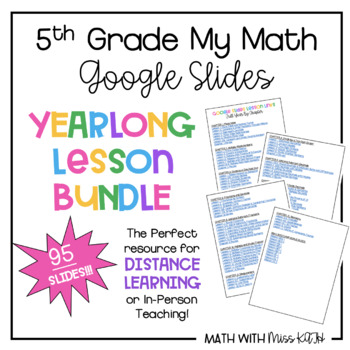5th Grade My Math YEARLONG GOOGLE SLIDES BUNDLE!
- PDF
What educators are saying
Description
You asked and IT'S FINALLY HERE!!!!!
This download includes a PDF with links to 95 Interactive Google Slides Presentations that cover ALL of the 5th Grade Common Core Standards!!!!!
These Google Slides were created as a resource to accompany the lessons in the McGraw Hill My Math curriculum. However, they directly align to the Common Core Standards and can easily be implemented with any 5th grade math curriculum. These slides can be used as an instructional tool for teachers to use in the classroom or in a DISTANCE LEARNING model!
Everything on the slides is completely editable, to meet the needs of your classroom. Review slides for have also been included as an End of Chapter review. The lessons are organized in the following format.
Lesson Format:
-Spiral Review Warm-Up
-Review of building block concepts/Vocabulary
-Model (I do)
-Let's Try It! (We do)
-You Try It! (You do)
-Problem Solving (word problems)
-Independent Practice Pages in Student Workbook (slide can be deleted if not using My Math)
At the end of the resource you will also find some EDITABLE bonus SBAC (state testing) Bootcamp Slides.
Check out an example lesson by downloading my FREEBIE below!
Powers & Exponents Google Slides FREEBIE!
Lessons Included in this Bundle
CHAPTER 1: Place Value
Lesson 1: Place Value and Number Forms
Lesson 2: Compare & Order Numbers Through Millions
Lesson 4: Represent Decimals
Lesson 5: Place Value Relationships
Lesson 6: Decimal Place Value
Lesson 7/8: Compare and Order Decimal Numbers
Chapter 1 Review
CHAPTER 2: Multiply Whole Numbers
Lesson 1: Prime Factorization
Lesson 3: Powers & Exponents
Lesson 4: Multiply with Powers of10 Exponents
Lesson 6: Multiply with Area Models
Lesson 7: Multiply with Distributive Property
Lesson 9/10: Multiply Multi-Digit Numbers with Standard Algorithm
Chapter 2 Review
CHAPTER 3: Divide by a One-Digit Divisor
Lesson 1: Relate Division to Multiplication
Lesson 2/6: Division Models
Lesson 3: Two-Digit Dividends
Lesson 4: Division Patterns
Lesson 5: Estimate Quotients
Lesson 7: Partial Quotients
Lesson 8: Three & Four Digit Dividends
Lesson 9/10: Quotients with Zeros and Place the First Digit
Lesson 11/12: Interpret the Remainder
Lesson 13: Determine Extra or Missing Information
Chapter 3 Review
CHAPTER 4: Divide by a Two-Digit Divisor
Lesson 1: Estimate Quotients
Lesson 2: Division Models
Lesson 3: Two-Digit Divisors
Lesson 4: Adjust Quotients
Lesson 5: Divide Greater Numbers
Chapter 4 Review
CHAPTER 5: Add and Subtract Decimals
Lesson 1/2/3: Round Decimals & Estimate Sums and Differences
Lesson 5: Add Decimals with Models
Lesson 6: Adding Decimals
Lesson 9: Subtracting Decimals with Models
Lesson 10: Subtracting Decimals
Chapter 5 Review
CHAPTER 6: Multiply and Divide Decimals
Lesson 1/9: Estimate Products & Quotients
Lesson 2/4: Use Models to Multiply Decimals
Lesson 3/5: Multiply Decimals
Lesson 6/14: Multiply & Divide by Powers of 10
Lesson 8: Multiplication Properties
Lesson 10: Use Models to Divide Decimals
Lesson 11: Divide Decimals by Whole Numbers
Lesson 13: Divide Decimals by Decimals
Chapter 6 Review
CHAPTER 7: Expressions and Patterns
Lesson 2: Order of Operations
Lesson 3: Write Numerical Expressions
Lesson 4: Work Backward & Make a Table
Lesson 5: Generate Patterns with Models
Lesson 6: Investigate the Pattern
Lesson 7/8: Coordinate Planes & Ordered Pairs
Lesson 9: Graph Patterns
Chapter 7 Review
CHAPTER 8: Fractions and Decimals
Lesson 1: Fractions as Division
Lesson 2: Greatest Common Factor
Lesson 3: Simplest Form
Lesson 5/6: Least Common Multiple & Comparing Fractions
Lesson 7/8: Write Fractions as Decimals
Chapter 8 Review
CHAPTER 9: Add and Subtract Fractions
Lesson 1: Round Fractions
Lesson 2/3: Add & Subtract Fractions
Lesson 5: Add Fractions with Unlike Denominators
Lesson 7: Subtract Fractions with Unlike Denominators
Lesson 9: Estimate Sums & Differences
Lesson 11: Adding Mixed Numbers
Lesson 12/13: Subtracting Mixed Numbers
Chapter 9 Review
CHAPTER 10: Multiply and Divide Fractions
Lesson 1: Multiply Fractions by Whole Numbers with Models
Lesson 4: Multiply Fractions by Whole Numbers
Lesson 5: Multiply Fractions by Fractions with Models
Lesson 6: Multiply Fractions by Fractions
Lesson 7: Multiply Mixed Numbers
Lesson 10: Divide Whole Numbers by Fractions
Lesson 11: Divide Fractions by Whole Numbers
Chapter 10 Review
CHAPTER 11: Measurement
Lesson 2: Customary Length Conversions
Lesson 5/7: Customary Weight/Capacity Conversion
Lesson 8: Line Plots
Lesson 10/12/13: Metric Conversion
CHAPTER 12: Geometry
Lesson 2/3: Triangles
Lesson 4/5: Quadrilaterals
Lesson 6/7: 3D Figures
Lesson 9: Volume
Lesson 11: Volume of Composite Figures
SBAC BOOTCAMP BONUS SLIDES:
Mission GEO 1
Mission GEO 2
Mission MD 1
Mission MD 2
Mission NBT 1
Mission NBT 2
Mission NF 1
Mission NF 2
Mission OA 1
Mission OA 2


